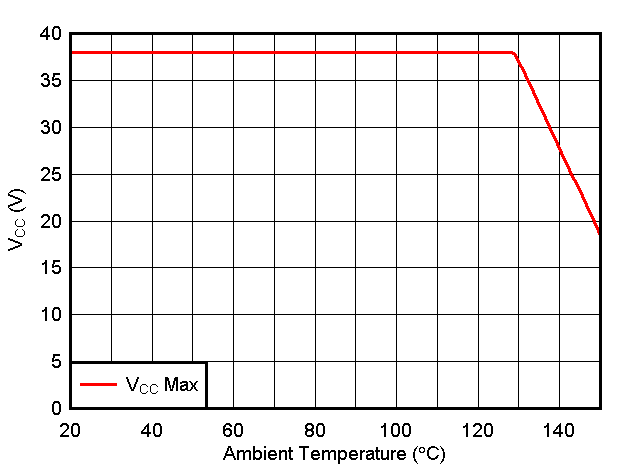SLYS029C July 2021 – December 2024 TMAG5110-Q1 , TMAG5111-Q1
PRODUCTION DATA
- 1
- 1 Features
- 2 Applications
- 3 Description
- 4 Device Comparison Table
- 5 Pin Configuration and Functions
- 6 Specifications
- 7 Detailed Description
- 8 Application and Implementation
- 9 Device and Documentation Support
- 10Revision History
- 11Mechanical, Packaging, and Orderable Information
Package Options
Refer to the PDF data sheet for device specific package drawings
Mechanical Data (Package|Pins)
- DBV|5
Thermal pad, mechanical data (Package|Pins)
Orderable Information
7.3.6 Power Derating
The device is specified from –40°C to 125°C for a voltage rating of 2.5 V to 38 V. Because the part is draining at its maximum a current of 17 mA the maximum voltage that can be applied will depend on what is the maximum ambient temperature acceptable for the application. The curve in Figure 7-24 shows the maximum acceptable power supply voltage versus the maximum acceptable ambient temperature.
The Figure 7-24 can also be calculated using the following formulas:

where
- TJ is the junction temperature
- TA is the ambient temperature
- ΔT is the difference between the junction temperature and the ambient temperature

where
- PD is the power dissipated by the part
- RθJA is the junction to ambient thermal resistance

where
- VCC is the voltage supply of the device
- ICC is the current consumption of the device
Combining the three equations above gives Equation 4 below:

This equation gives the maximum voltage the part can handle in regards of the ambient temperature.
For example, with an the application required to work within a ambient temperature of maximum 85°C, and TJmax, RθJA and ICCmax are defined in the data sheet, the maximum voltage allowed for this application is determined in Equation :

 Figure 7-24 Power Derating Curve
Figure 7-24 Power Derating Curve